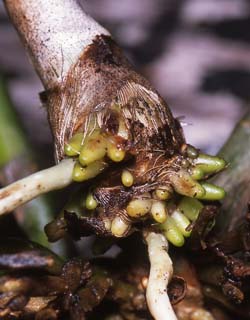|
Welcome to the AOS Beginner's Newsletter. We will be sending you monthly tips on how to grow orchids and help you get them to bloom again. In addition to the information presented here, we invite you to visit the AOS website at www.aos.org and check out the information found under ORCHID INFORMATION > ORCHID BASICS.
Spring Has Sprung
Today is the first day of spring and for orchid growers, that means our orchids will be commencing their annual growth cycle soon. Depending on where you live, some plants may be in growth already. As we head toward summer we will be practicing a different culture regime for our orchids. We want to optimize their growth as much as possible during the warm part of the year. The most important task we associate with spring is repotting our plants. I often hear of a novice buying an orchid and immediately repotting it regardless of the time of year. That is not sound practice. The best, and safest time to repot an orchid is in the springtime and there are good reasons
why. Lengthening days continue to accelerate plant growth through the summer
solstice. With some species, growth can be explosive at this time of year. Orchids that receive ample food and water, and the proper temperatures and light for their type, can quickly fill a pot with roots. The more roots, the better a plant can utilize the nutrients it receives. This rapid growth also insures that newly potted orchids will quickly establish themselves in the fresh medium. All of this adds up to a strong, healthy plant capable of producing abundant blooms.

While there are exceptions, for most orchids it is a safe bet to repot in the
spring. It is a good idea to confirm that your orchids are indeed beginning
their growth cycle. Monopodial and sympodial orchids should both have some active, green root tips on mature roots. Sympodial orchids should have a cluster of new roots starting from the base of the newest pseudobulb and may or may not have a new pseudobulb starting. The longer the new roots are the easier it is to accidentally break them so try to repot plants when these roots are not much more than a half-inch long. Soaking a plant in a bucket of room temperature water will make old roots more pliable and easier to remove from the pot. This is especially helpful with monopodial orchids like Phalaenopsis.
Repotting orchids is fairly straightforward and once you get the hang of it, it becomes an enjoyable part of the hobby. There are a few rules to remember...
- Always sterilize cutting tools between plants to avoid the spread of disease. A minute or two under a torch flame will suffice.
- Remove old medium and dead roots. Leafless backbulbs may be removed from sympodial orchids.
- Use fresh, clean media and pots, do not recycle media, and reuse pots only if they have been sterilized.
- Potting time is a good time to examine plants for any pests that might be hiding. Spring cleaning applies to orchids too! Remove any old, dried sheaths with a toothbrush dipped in 70% isopropyl alcohol. Also remove any dead leaves or pseudobulbs.
- Makes sure that all of the needed materials are at hand, that includes assorted pots, enough of your preferred media, rhizome clips and/or bamboo or wire stakes and don�t forget nametags!
If you pot them correctly, most orchids only need to be repotted every second or third year. Some, like phalaenopsis and catasetums appreciate fresh medium every year.
Greg Allikas
March 2012
|

